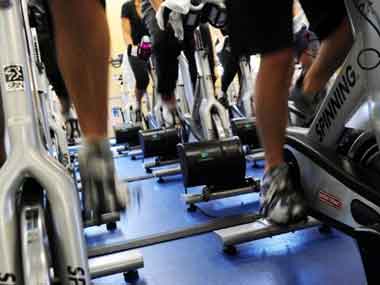For most of us, a hectic workweek involves sitting for long periods and a lot of stress. Throw in the occasional run in the park or gym session in pursuit of the elusive work-life balance, and workout injuries are par for the course. It happens to the best of us: first, it becomes harder and harder to find time for the sports we loved as teens. Then, even the cherished jog outdoors becomes a chore to stay fit. Eventually, the jog is relegated to weekends or gets slotted into a busy schedule as an afterthought. [caption id=“attachment_2147561” align=“alignleft” width=“380”]  Representational image. AFP[/caption] The most common causes for workout injuries can be chalked up to a sedentary lifestyle, and then suddenly being required to perform an athletic movement - often, without warming up before. In many cases, a direct injury while playing sports like getting hit by a cricket ball or being tackled on the football field can also put one out of action for some time. Injuries occurring in the sports field or the gym usually involve muscle strains and sprains, bone fractures and ligament tears. Here are some of the common injuries that you should look out for:
1. Knee injury
Does your knee hurt when you bend it or while you’re walking? Chances are you have injured yourself in the gym or during a long morning run. Whether you’re performing squats and deadlifts in the gym, doing cross-fit exercises, running or playing a sport, your knee injuries are not uncommon in any of these. Most sports injuries involve the lower part of the body. The reason: constant impact with the ground, and regular use of your limbs. An injured patella or knee joint can also lead to swelling, which can be alleviated with rest and by applying ice to the swollen area. Sudden movements like rotating or pivots can also lead to sharp pain. More severe situations like a tear in the Anterior Cruciate Ligament (ACL) can require surgery and extensive physical therapy. It is always a good idea to warm up before performing an exercise or wear a knee brace if you have frequent aches and pains emanating from the knee.
2. Herniated disc
A sedentary lifestyle followed by rigorous exercise is often harmful to the spine due to the sudden change in physical strain. Paired with poor technique while lifting weights or applying pressure on the back without rest, it can lead to problems like a slipped or herniated disc. Our spines are made up of small bones stacked one on top of the other. There’s a rubbery cushion (or discs) in-between the bones to reduce friction. Now, these rubbery discs have two parts: a soft jelly centre and a firmer exterior to hold it in place. Sometimes, like during vigorous exercise or when we have bad posture, one of these discs can develop a problem: the squishy centre can spill through the exterior and pinch a nerve. This, as you can imagine, can cause excruciating pain. If not treated on time, the pain from a herniated disc may reach the legs, impeding your mobility. A lot of rest is recommended if you feel such pain. An orthopaedic or a physical therapist can also show you proper stretches and exercises to recover. Severe situations may require surgery.
3. Hamstring pull
A majority of sports involve a lot of running. This leaves athletes vulnerable to the possibility of injuring their hamstring muscles that are located in the back portion of the thigh. Lack of proper stretching or warming up before exercise, or overusing the muscles are the most common causes, but they are responsive to treatment, and frequent stretching and strengthening of the hamstring can prevent it from happening again.
4. Ankle sprain
As expected, our joints are most susceptible to injury, and our ankles are no different. Exercises or sports involving a frequent and quick change of direction or jumping may cause you to roll over on your ankle. Ankle injuries can be seriously debilitating, causing you to limp as you wouldn’t be able to put too much pressure on the injured area. You should keep your ankle elevated during rest and avoid movement as much as possible. You can often see the outside of the ankle swollen up if you have had a fall or twisted your ankle recently. While on most occasions people make a full recovery within weeks, a more severe injury – made obvious by severe pain – may mean a tear in the ligaments, which may take longer to heal. If you have injured your ankle before, chances are you will do it again. Doctors and physical therapists advise regular exercise to also strengthen the area.
5. Groin pull
Exercises involving a lot of sprinting, sudden stopping and sideways movements can lead to strain in your groin or the muscles in your inner thigh. Tenderness or swelling is experienced as a result, but with a combination of rest, frequent icing of the area and compression, you can be on your way to full recovery quickly. Be careful not to rush back into the sport full steam, as the risk of re-injuring your groin is quite high.
6. Shin splints
Long-distance running enthusiasts or people who enjoy playing football or sports that involve a lot of running usually complain of shin splints. Those who enjoy trekking in the mountains or activities that involve walking up can also complain of pain in the lower front leg. Overuse or overtraining can cause a burning sensation and pain in the shins and it is best to take a break from the activity. Icing the area is often enough to alleviate the pain. In some cases, over-the-counter pain medication can also help, but frequent overuse or not giving enough attention to the problem can lead to stress fractures, which would then require visits to the doctor.
7. Concussion
The most common form of head injury is often experienced with a blow to the head, mostly in the field of play during a game of cricket or while playing any kind of a contact sport. There may be cases when you won’t even feel anything immediately, but have a delayed episode of concussion. Concussions are very different from suffering a muscle strain, as it is usually a sharp blow that causes it. While it is difficult to take precautions against such an event, it is advisable to wear the right protective equipment for the sport you’re playing, like a helmet while batting in a game of cricket. But in the event of a concussion, be sure to stop play immediately and visit a doctor or a hospital. Symptoms could include dizziness, blurred vision or even short-term memory loss.
8. Shoulder/rotator cuff injury
A lot is riding on our shoulders, quite literally. Excessive weightlifting over the shoulders, playing racket sports like badminton, squash and tennis, as well as while bowling in a game of cricket, can open up the rotator cuff to injury. Overuse of the rotator cuff can also cause problems. Sharp pain while raising your arms above your shoulders is often a symptom, as is experiencing pain while rotating your arm or trying to reach your back. Taking a break from the activities that caused it is a start, as the nature of the injury is degenerative - it will keep getting worse. It is also advisable to see a doctor immediately if you experience any of the symptoms. Health articles in Firstpost are written by myUpchar.com, India’s first and biggest resource for verified medical information. At myUpchar, researchers and journalists work with doctors to bring you information on all things health. For more information, please read our article on Shoulder Pain: Causes and Treatments_._


)

)
)
)
)
)
)
)
)



